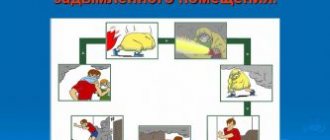Lightning strike is a life-threatening condition that occurs as a result of lightning striking directly a person or nearby objects.
Lightning is a powerful electrical discharge in the atmosphere, usually during a thunderstorm. Lightning also occurs during volcanic eruptions, dust storms, and tornadoes. Lightning can discharge inside a cloud, between the cloud and an object located on the surface of the earth, water, or in the air. The likelihood of a person being struck by lightning is very low, but such cases usually have serious consequences. Damaging factors of lightning: electric discharge, powerful sonic boom, light flash.
It is most likely to become a victim of lightning while being in an open space during a thunderstorm - in a field, meadow, or on the surface of a reservoir; on a hill - in the mountains, on the roof of high-rise buildings; under lonely trees.
What kind of danger is this?
Lightning damage is included in the list of life-threatening conditions. This is the result of a discharge hitting both directly his body and nearby objects.
Lightning is a powerful electrical discharge in the atmosphere, which in most cases is observed during a thunderstorm. In rare cases, such a natural phenomenon is typical for a tornado, volcanic eruption, or dust storm. Most often, lightning discharges in the atmosphere, inside a cloud. But cases are not excluded when this happens between a cloud mass and another object - a building, a car, a living creature.
There are several damaging factors for this phenomenon:
- Electric discharge.
- Flash Light.
- Powerful sound wave.
Greatest danger
You put yourself at greatest risk during a thunderstorm in the following cases:
- Being in an open space - in a meadow, in a field.
- Floating on the surface of a body of water.
- Standing on a hill - both in the mountains and on the roof of a building.
- Being under a lonely tree.
Why is it so important to properly provide assistance during a lightning strike? In 30% of cases, the incident results in the death of the victim. Even if a person survives, the injuries received can leave him disabled.
Why is lightning dangerous?
The danger of lightning is that when it hits a person (or another object located near a person), a strong electric shock occurs - electrical injury. As a rule, first of all, a lightning strike affects the heart, since this organ acts on an electrical principle (the heart rhythm is disturbed, the heart stops, etc.). Being struck by lightning is one of the most serious injuries. However, only about 30% of people actually die from a lightning strike.
Note: It is worth noting that lightning “does not spare” anyone - neither children nor the elderly. However, according to statistics, men suffer from lightning strikes more often than women.
Symptoms of the lesion
Depending on a number of factors (where the person was, what he was doing, what he was holding in his hands, etc.), a person, including a child, may or may not notice a lightning strike. There are often cases where the symptoms of an impact appear a little later after the incident.
Symptoms of lightning damage are as follows:
- loss of consciousness;
- the appearance of a burn on the body, sometimes in the form of a “pattern”;
- there may be a fire at the scene;
- lack of coordination;
- sleep disturbance;
- hearing loss;
- partial memory loss;
- hallucinations;
- darkening of the eyes;
- headaches and dizziness;
- possible decrease in temperature and pulse;
- convulsions;
- paralysis.
Note: It is worth noting that usually after a lightning strike a person falls. However, sometimes one remains standing (if lightning does not hit a person, but the ground, a tree, an umbrella, etc.).
Symptoms of the lesion
To provide first aid in the event of a lightning strike, you first need to determine that just such an incident happened to the victim, and not another misfortune. There are several distinctive features:
- You will see burns where the electrical discharge enters and exits the body.
- One of the accompanying severe factors is that a lightning strike can cause a fire in the clothes of a victim of a natural phenomenon, or even a fire around it. This leads to deep, large-scale burns on the body.
- Red and bluish stripes appeared on the victim’s skin, somewhat reminiscent of a pattern of blood vessels.
- Mechanical injuries - lightning damage can cause a person to fall, be struck by foreign bodies (displaced by the force of the phenomenon or its consequences), or be struck by a sound wave. Fractures, bleeding, and separation of limbs are often diagnosed.
- Delirium, hallucinations.
- Loss of hearing, vision, disorientation.
- Stopping breathing and blood circulation. This is a consequence of damage by an electrical discharge to the respiratory and vasomotor centers of the victim’s brain.
- Impairment or complete loss of consciousness by a person.
How to behave before a thunderstorm
Now, during the construction of high-rise buildings, various structures, television towers and various masts, special devices are installed that absorb all lightning strikes. Lightning protection, or so-called lightning rods, are special grounded metal masts and wires stretched between them over structures. They just attract all the electrical discharges during a thunderstorm.
A sure way to avoid getting caught in a thunderstorm is to know the weather forecast for the near future. If a thunderstorm is expected, then you should not go to the forest, for a picnic or fishing; reschedule this event for another day. It is not safe to be on the bank of a river or in a field during a thunderstorm.
But if you find yourself outside your home or work and hear thunder, first determine where the storm front is heading. This is easy to do with simple calculations. It is necessary to determine the approximate distance to it and find out in which direction the thunderstorm front is moving.
When you see lightning, count how many seconds it will take for the sound of thunder to reach you. To estimate whether the front is moving away or approaching the next lightning flash, calculate the distance to the front again.
It's done like this. The speed of light is 300,000 km/sec, and the speed of sound is 340 km/sec, i.e. We will hear the sound a little later than we see the flash of lightning. What follows is simple arithmetic. We multiply the speed of sound per second by the number of seconds obtained when calculating the time of thunder appearing after lightning. We get the following example: 340 km/sec multiplied (for example) by 5 seconds and we get 1700 meters. This is the distance to the storm front. We will make the same calculation after the second lightning flash.
If a thunderstorm front is approaching you, then you need to worry about your safety. What needs to be done for this?
Is the victim a danger to rescuers?
If you know that a person has been struck by lightning, do not be afraid to touch him, thinking that you will be electrocuted!
Unlike all other electrical injuries, the victim’s body is not under voltage. Feel free to begin providing first aid if a person is struck by lightning. There is no need to wear protective rubber gloves and try to “disconnect” it.
Burying a person who has been electrocuted in the ground is a big mistake, which could cost him his life! Previously, this was done, hoping that the electric charge from the body would go into the ground, and the victim would “come to life.” In fact, the current passes through his body in a fraction of a second, leaving no voltage behind.
Consequences of lightning striking a person. Facts and fictions.
Every minute 6 thousand lightning strikes the ground. The probability of a human being affected is approximately 1 in 600 thousand, with approximately a third of victims dying on the spot, and survivors suffering serious injuries. The statistics are very imprecise, but they give a general picture: the mortality rate from direct impacts is much lower than, for example, from car accidents or viral diseases. Nevertheless, the risk of defeat exists, and the consequences can be the most unexpected and surprising.
Differences between a lightning strike and a household electric shock
The human body perfectly transmits electricity - within reasonable limits. In fact, a lightning strike is a very powerful electric shock, classified by medicine as an electrical injury. The discharge voltage is about 300 kW, and in household appliances it rarely exceeds 20-30 kW. In this case, the duration of contact with lightning is 3 milliseconds, and damage in domestic conditions can last 500 milliseconds or more.
The celestial discharge heats the air around, causing burns and bizarre patterns on the skin - due to the rupture of blood vessels. Electric shock usually affects the hands and wrists. Lightning strikes the chest or head.
Symptoms of the lesion
- Burns. Not only in the affected areas. The discharge causes clothing to ignite and a fire to occur at the scene.
- Injuries due to falls or damage from foreign objects.
- Hallucinations.
- Loss of consciousness.
- Heart failure.
- Disorders of the musculoskeletal system.
Consequences of a lightning strike
The discharge penetrates the body, leaving burns - entry and exit. There may be several of the latter. The blow is struck from below - from the ground. The most common cause of death is cardiac arrest and first aid not provided in a timely manner. The person falls into a state of shock, which many victims compare to waking up from sleep. In addition, cases of paralysis developing after a shock are common.
Hearing and vision
Approximately 50% of victims from a direct hit suffer serious problems with hearing and vision. Within 2-3 days or several years, cataracts develop, cases of retinal detachment, optic nerve atrophy and bleeding have been recorded.
Tinnitus and temporary hearing loss, dizziness, infectious diseases of the middle ear - the consequences of the blow haunt victims throughout their lives. Immediately after the impact, the eardrums may rupture.
Leather
Extensive 1st and 2nd degree burns and vascular ruptures leave lifelong marks on the body. Inflammation and redness of the skin appear, which disappear after a few days.
Nervous system
Cerebral hemorrhage, internal hematomas, amnesia and general paralysis - injuries to the central nervous system are inevitable when struck by lightning. Also, after rehabilitation, neuropsychiatric diseases may develop.
The cardiovascular system
If you manage to quickly restore normal heart rhythm, the consequences will be insignificant. But if resuscitation is not carried out, the person dies from hypoxia and lack of oxygen.
Muscular system
The discharge affects the muscles, causing toxic secretions that severely damage the kidneys. Due to strong contractions of muscle tissue during an impact, bones break, and there is a high probability of a spinal fracture.
Amazing abilities revealed in people after defeat
Roy Cleveland Sullivan
A Kentucky park ranger has been hit 7 times in 34 years. After his last defeat, Roy lived another 6 years and committed suicide at 71! An amazing incident is included in the Guinness Book of Records. Fearing that he would be discharged like Sullivan's wife during his defeat in the summer of 1977, those around him shunned the sky-marked forester throughout the last years of his life.
Jorge Marquez
The Cuban survived after being hit 5 times. The first three lesions provoked severe burns of the limbs and back, complete burning of hair and loss of fillings from the teeth. But it is surprising that all subsequent blows did not cause any serious damage. Jorge is alive, for his own safety he does not go outside in a thunderstorm.
Vladimir Ignatievich Dronov
At the beginning of the twentieth century, a retired captain, who was 50 years old, was struck by lightning while hunting. Dronov lost consciousness for about 30 minutes. The discharge did not cause any serious consequences; strange things began later. Within a few months, the bald spot was covered with thick hair, all the teeth fell out, but after a short time new ones came out!
Bruno Di Filippo
A Massachusetts man received a shock while peacefully watering his front lawn. The lightning went over the shoulder and out through the ankle. Doctors stated that the blow caused absolutely no harm to the body. Only a slight scar remained on the body, which disappeared without a trace over time.
Vanga
The Bulgarian healer, known throughout the world, suffered from a hurricane and lightning strike as a child, losing her sight, but gaining the gift of prediction.
Harold Dean
After being struck by lightning, Harold became immune to the cold: even in winter, the Missouri resident goes outside in just a T-shirt.
Vasily Saiko
Penzyak received a discharge from ball lightning, which passed through the chest and came out from the back, without causing visible damage or damage to internal organs. However, upon examination, it turned out that the chronic stomach ulcer that tormented Vasily had disappeared without a trace.
Wagner Casey
At an off-road race in Texas, Wagner and his friends were caught in a thunderstorm. Trying to hide under a tree, the man received a powerful shock. Having fallen to the ground, the unfortunate man was struck by lightning for the second time. Casey was immediately hospitalized and suffered minor skin injuries and loss of sensation in his right leg. After a few weeks, the victim made a full recovery.
Common myths about lightning
You can't hide from lightning even in a building
When it hits a building, the discharge goes into the ground through lightning rods. The house is one of the safest places during a thunderstorm: people most often receive blows in open areas, near bodies of water or under trees. An equally safe place is a car with a solid roof.
Lightning shoots down planes
At least once a year, a discharge hits an airplane, but rarely leads to plane crashes: the body of the airliner is made of metal that perfectly conducts electricity.
Lightning doesn't strike in the same place twice
A common misconception that has no scientific basis. The discharge can hit the same object twice. For example, a structure 500 meters high receives 50-80 hits annually. In addition, physicists have calculated that after the first discharge, lightning will strike within a radius of 10 to 100 meters with a probability of 67%.
Lightning only occurs when it rains
As long as thunder is heard, there is a danger of being struck by lightning. At the same time, rain can fall 10 kilometers or further.
If you touch the victim, you may receive an electric shock
A terrible misconception, due to which first aid is often not provided to the victim. In reality, the human body is not capable of holding an electrical discharge.
Mobile phone is dangerous in a thunderstorm
Science provides no evidence to support this myth. Only a phone with a metal casing that comes into contact with the skin can increase the likelihood of being struck by lightning.
It is the responsibility of everyone who witnesses a lightning strike to a person to provide first aid and call a doctor. It's not difficult, and there's a good chance you'll save the victim's life!
Interesting materials on this topic:
Consequences of a lightning strike to a person
In this article you will learn about the dangers a lightning strike can pose to the human body. The results of a direct hit and the consequences that the discharge can cause in the long term are described. Statistics of damage in the results of thunderstorms and lightning are also presented.
Lightning as a weapon
What did lightning mean in ancient mythology, its symbolism in the weapons of ancient peoples? Tesla's experiments and Franklin's invention, history of experiments and modern developments. Why do they try to control lightning and how are they taught to protect it?
Is it possible to use a phone during a thunderstorm?
Lightning and lightning protection
Providing first aid for a lightning strike: an unconscious person
The victim needs immediate professional assistance to save his life! Therefore, first of all, call an ambulance - in this case, a team of resuscitators will arrive.
But you shouldn’t just stand and wait for doctors - even a non-professional can save the victim’s life. First aid for a lightning strike - determine whether the person is conscious or unconscious. In the second case, we do this:
- Pull yourself together, don't panic - only by being calm can you really help.
- Check for heartbeat and breathing. The easiest way to do this is by placing your finger on the carotid artery in the victim's neck.
- If breathing and heart rhythms are absent, then you should immediately move on to chest compressions and artificial respiration.
- Lay the victim on his back on a hard surface.
- If you are acting alone, then simple instructions: take two mouth-to-mouth breaths. Then fifteen presses with clasped palms on his chest.
- If you provide assistance with a friend, then the “breathing-massage” ratio is 1:5. It is better to act one by one.
- Continue until the ambulance arrives or until the victim breathes on his own, his pupils constrict, and his skin turns pink.
Try to do at least 12 blows of air into his lungs and at least 72 presses with your palms on the chest of the victim of a lightning strike in a minute.
Providing assistance if the person is conscious
What will be the first aid for a lightning strike if the victim is conscious? Less dangerous case, but requires assistance:
- First of all, call an ambulance.
- Take the victim to cover.
- Change his clothes and put him to bed.
- Cover with a warm blanket.
- Give the victim some warm, sweet tea. If you have a first aid kit on hand, 30 drops of valerian or corvalol tincture will help.
- Do not leave the victim's side until the ambulance arrives. All this time, monitor whether he is conscious, what his breathing and heartbeat are like.
Rules of conduct during a thunderstorm
Terrible consequences after a lightning strike can be avoided if you know and follow the rules that help prevent encounters with a dangerous natural phenomenon.
The most common place for lightning to strike is high objects. Therefore, at the present stage of construction of high-rise buildings, designers always provide for the presence of lightning rods. This is the name for special grounded devices made of metal, which consist of masts and wires stretched over the house. Lightning rods “take on” the discharges of electricity that occur during a thunderstorm.
The most reliable way to protect yourself from the effects of thunderstorms is not to go outside during bad weather. You can learn about the impending disaster from weather forecasts. Hiking, fishing or other trips outside the home should be cancelled.
If, due to circumstances, it was not possible to prevent being outside during a thunderstorm, you need to act wisely.
- Move as far as possible from all tall buildings, trees, pillars;
- If you are in an open field, do not lie down on the ground! Squat down, imitating the fetal position, and in this position, wait for the end of the thunderstorm;
- If you can find natural depressions in the ground (ravines, holes), it is better to hide there;
- If you are on the shore of a body of water during a thunderstorm, immediately leave this place, moving as far from the shore as possible;
- If a thunderstorm begins while riding a bicycle or motorcycle, the vehicle must be stopped, get off and move to a safe distance (20 meters);
- Being in a car during a thunderstorm provides fairly good shelter, so you need to stop the car and wait for the end of the bad weather there, after removing the antenna.
Note!
Wherever you are, remove all jewelry and throw away items containing metal. Turn off your communications! These things attract lightning, which greatly increases the risk of a lightning strike.
If you exercise caution and stay home during a thunderstorm, remember that you still need to follow important rules of conduct:
- Make sure that windows, doors, chimneys and ventilation are tightly closed;
- Avoid being near electrical wiring, windows and drainpipes;
- If you have stove heating, avoid lighting the stove during a thunderstorm;
- Turn off household appliances.
You should also avoid taking water treatments at this time.
If there is bleeding
Providing first aid in case of a lightning strike also means stopping the bleeding (if it exists).
Arterial. The rescuer can do the following:
- If the damaged artery is clearly visible, then you can really press it with your finger or fist just above the site of the lesion - to the victim’s bone.
- In other cases, a tourniquet - a strong elastic tape - is also applied above the lesion site. It can be a belt, sling, rope, etc. A note is placed under the tourniquet with the time it was applied. Every 30-40 minutes in winter and 60-90 minutes in summer it weakens, after which it tightens again. This way you will save the victim from tissue necrosis due to prolonged compression.
Venous. Here's how they do it:
- A sterile pressure bandage is applied to the wound.
- If ineffective, a tourniquet is placed below the wound.
If there are burns
First aid for electrical injury and lightning strike includes treatment of burns:
- Take the person out of the area exposed to high temperature, extinguish the clothes on him.
- If possible, remove smoldering remains from it. The best way to do this is to trim the clothing around the areas where it has burned to the skin. These damaged locations are covered with a sterile bandage.
- A bubble, container with cool, cold water, ice or snow is applied to the burned surface through a clean gauze bandage for 15-20 minutes. But with extensive lesions this cannot be done!
- Give the victim a cold drink - preferably plain water.
- If available, offer him pain medications.
- Remove jewelry and watches from the person - this will prevent swelling later.
- The dressings should be bandage, sterile, not pressing. Cotton wool cannot be used!
- Secure the burned part - the person should not lie on it.
- If the burn is extensive, the victim should be wrapped in a clean sheet.
You know how to help a person who has been struck by lightning. The first step in any case should be to call an ambulance!










